
Jamie Revell
The Order uses a clenched iron gauntlet as its symbol, painted onto the shields of its knights and adorning its banners.
Origins
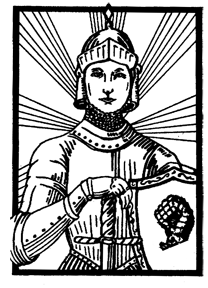 Josselyne was the eldest son of a powerful Brithini talar (noble) who ruled a domain in present-day Junora in the early first century. The entire noble house converted to the Malkioni Way after their first encounter with missionaries only a few years after Hrestolís martyrdom. They taught the new religion to all the inhabitants of their domains, who eagerly converted en masse. The act naturally brought condemnation from neighbouring Brithini talars and Zzaburi, but the military expertise of Josselyneís father, Talar Mandol, discouraged them from taking any direct action. When Mandol died in the year 64 and Josselyne inherited his domain, matters rapidly took a turn for the worse.
Josselyne was the eldest son of a powerful Brithini talar (noble) who ruled a domain in present-day Junora in the early first century. The entire noble house converted to the Malkioni Way after their first encounter with missionaries only a few years after Hrestolís martyrdom. They taught the new religion to all the inhabitants of their domains, who eagerly converted en masse. The act naturally brought condemnation from neighbouring Brithini talars and Zzaburi, but the military expertise of Josselyneís father, Talar Mandol, discouraged them from taking any direct action. When Mandol died in the year 64 and Josselyne inherited his domain, matters rapidly took a turn for the worse.Believing that the young man could not have the skill or magic to resist them effectively, a coalition of the local talars was formed to crush him and kill all his subjects who would not renounce their faith. By doing so, the Brithini hoped to make a powerful example, and discourage any further mass conversions in their area, as had already happened further west (in present-day Loskalm). However, they had badly miscalculated, for the rebellious household and their knights showed a dogged determination never to surrender or to yield any ground without exacting a terrible toll on the invaders. As the fighting continued through the year, at times literally house to house through the villages, the Brithini five times offered peace if only the defenders would abandon the Malkioni Way. None did, yet the Brithini felt they had no choice but to press on, no matter what the cost, for they could not back down once they had made such threats.
The overwhelming superiority of numbers on the Brithini side, combined with their vastly superior resources made their victory inevitable, no matter how hardly bought it would be. At the last, they faced the final few defenders, lead by Josselyne himself, within the walls of the ancestral castle. As they prepared themselves to face their doom, the defenders witnessed a miraculous event. A vision of the martyred prophet appeared in the air above the castle battlements, and blessed all the defenders with the certainty of Solace in Glory, not only for themselves, but for all those Malkioni who had been slain by the Brithini during the year-long war. So persuasive was the vision that four of the Brithini warriors besieging the castle switched sides and joined the defenders in their last hopeless struggle.
In the years since, the story grew with the telling, and the name of Josselyne became a by-word for valiant resistance against overwhelming odds, and for strength in the face of adversity. Anyone may pray to him for the strength to continue with their tasks, while his Order is especially important to those whose job is related to defence, such as garrison troops or the builders of castles. Members of his Order build their physical strength up as a symbol of their inner will, and to better wield weapons in the defence of their fellows.
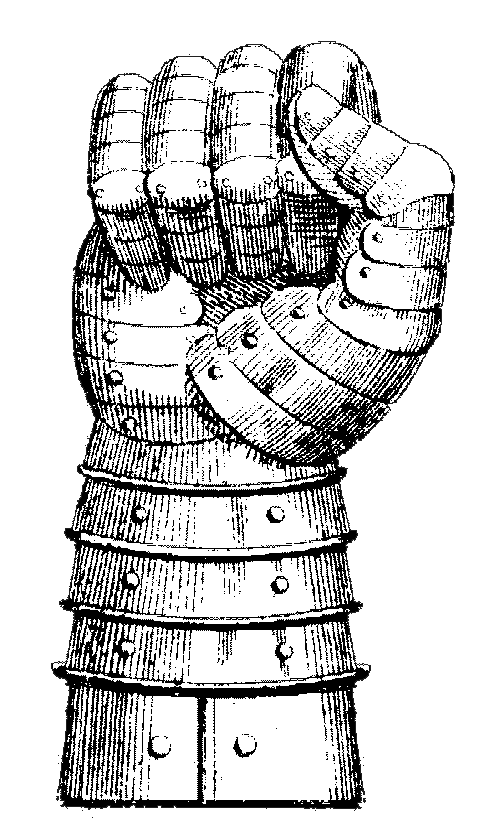
Keyword
Entry Requirements: Must be a male member of the Knight or Noble classes.Abilities: Athletic, Strong.
Virtues: Determined, Energetic.
Scripture: The Life of Saint Josselyne
 Common Blessings: Ignore Distractions, Resist Fatigue, Resist Fear, Strong Will
Common Blessings: Ignore Distractions, Resist Fatigue, Resist Fear, Strong Will
 Special Blessings: Bless Sword, Increase Strength, Strengthen Armour.
Special Blessings: Bless Sword, Increase Strength, Strengthen Armour.
Grimoire:
 The Book of Irresistible Strength (Banish Fear, Fist of Steel, Hurl Heavy Stone, Ignore Crippling Injury, Impede Invaders, Reinforce Armour, Resist Magical Coercion, Strengthen Sword Arm, Unbreakable Sword).
The Book of Irresistible Strength (Banish Fear, Fist of Steel, Hurl Heavy Stone, Ignore Crippling Injury, Impede Invaders, Reinforce Armour, Resist Magical Coercion, Strengthen Sword Arm, Unbreakable Sword).
Icons and Images: Images of the saint depict him wearing the heaviest armour of the period and bearing a mighty broadsword in one hand and a sturdy shield in the other.
Saintís Day: 5th Sementis, the anniversary of the saintís martyrdom.
Other Side: The Fortress of Strength in the Saint Plane is a cyclopean castle.
Disadvantages: Members of the Order take a vow never to surrender to non-Malkioni, and must always keep themselves in peak physical condition.
Philosophy and Membership
The central tenet of the Order is that The Strength Without Mirrors The Strength Within. Knights of Saint Josselyne are expected to keep themselves in peak physical condition, with a daily regimen of exercise and martial practice, wherever possible. By building a strong and healthy body, they are better able to maintain the willpower and dedication necessary for a true knight. They favour outward expressions of strength and solidity, such as powerful fortresses and heavy armour. While there is no official restriction on the weapons that they use, many prefer the heaviest weapons available, especially two-handed swords.Because of this emphasis on physical prowess, most chapters only accept male members, even where women are otherwise permitted to become knights. Even in those rare places where this is not the case, such as some parts of Loskalm, female applicants are few, and usually develop muscular bodies far from the ideal of Western beauty. All members of the Order must either be knights, or squires on the path to knighthood. In some countries, such as Seshnela, this may include some members of the noble caste as well as the more traditional knight caste.
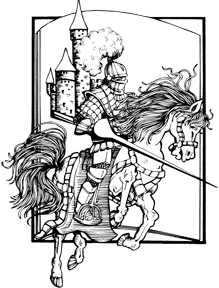 The development of physical power and strength is not, however, an end in itself. The demanding regimen is intended to build character and reinforce devotion to holy ideals. Cowardice is one of the worst sins a Josselyni can commit, and a true knight should be as strong of will as he is of sinew. Similarly, the Order recognises the highest virtue as a determination to succeed and to protect the Church and its followers. This rigid attitude has made the Order slow to change and to adopt new practices, although, inevitably, much has altered down the more than fifteen centuries of its existence.
The development of physical power and strength is not, however, an end in itself. The demanding regimen is intended to build character and reinforce devotion to holy ideals. Cowardice is one of the worst sins a Josselyni can commit, and a true knight should be as strong of will as he is of sinew. Similarly, the Order recognises the highest virtue as a determination to succeed and to protect the Church and its followers. This rigid attitude has made the Order slow to change and to adopt new practices, although, inevitably, much has altered down the more than fifteen centuries of its existence.
The Order of Saint Josselyne is generally not a crusading order, although individuals may certainly seek to prove their prowess against pagan or heretical foes. Their primary role is the defence of the faithful, and they favour the construction of strong fortifications to guard frontiers and other vulnerable locations. In battle, they rarely form the vanguard of an army, but guard the flanks, establishing an impenetrable barrier of shields and armour to repel enemy assaults. Similarly, they are commonly used to guard forts or other outposts in hostile territory.
The Orderís beliefs are generally compatible with all the major branches of Malkionism. While the majority of modern Josselyni are members of the Idealist Church of Loskalm, this is a simple factor of demographics, and of the Loskalmi approach to saintly devotion. In no country is the order dominant amongst military religious orders, although it is usually an important presence. In Seshnela, knights of the Order are mostly loyal Rokari, following the tenets of that faith, while in Loskalm they are equally dedicated Idealists. The Order is also common in Jonatela and its neighbouring lands, although it less popular in Ralios, where knights are more likely to follow one of the multiple competing henotheist and Arkati sects.
Despite their primarily defensive role, individual Josselyni often join hero bands or other associations that campaign more actively. Their magic makes them powerful warriors, and they are dedicated to protecting the faithful from all manner of outside threats. The neutral position of the Order politically makes it possible for them to work alongside all manner of other heroes, from healers to wizards and fellow knights. Similarly, knights of Saint Josselyne may hold any of a number of differing political or religious beliefs of their own, so long as these are broadly compatible with the Orderís aims.
There have been several instances in the past where Josselyni knights have found themselves on opposite sides of a conflict, for example, in the wars between Loskalm and Jonatela over rule of Oranor. Their primarily defensive role in combat has minimised the number of direct clashes, but, in most cases, they have not flinched from battle when the situation has arisen. Indeed, the modern Rokari and Idealist branches of the Order have barely communicated with each other since the fall of the Ban, each regarding the other as heretical. That the Rokari claim Josselyneís final vision was of Malkion, while the Idealists claim it was of Hrestol, only serves to deepen the divide.
History
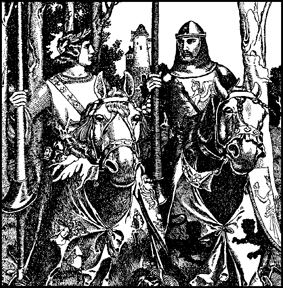 A small band of Josselyneís surviving followers founded the Order after his martyrdom in the year 65. The Malkioni Church was still a persecuted minority in Fronela in those days, existing largely in hiding and in rural communities while the Brithini ruled the cities. As a result, little is known of these very early years, when the very institution of knighthood was mistrusted at best, and at worst, punishable by death. By the time significant Malkioni communities arose to challenge Brithini rule, many chose Josselyne as their patron, as a martyr in the face of oppression.
A small band of Josselyneís surviving followers founded the Order after his martyrdom in the year 65. The Malkioni Church was still a persecuted minority in Fronela in those days, existing largely in hiding and in rural communities while the Brithini ruled the cities. As a result, little is known of these very early years, when the very institution of knighthood was mistrusted at best, and at worst, punishable by death. By the time significant Malkioni communities arose to challenge Brithini rule, many chose Josselyne as their patron, as a martyr in the face of oppression.In the second century, the Order of Saint Josselyne grew in influence, one of only two significant religious orders of chivalry. Its knights were less closely associated with Hrestol than their rivals in the Order of Saint Carpattia (see the Book of Glorious Joy, p.93), but were vigorous in defence of the Church and its worshippers. Unlike the Carpattians, the early Josselyni favoured smaller groups, with no centralised control, and no single leader for the Order as a whole. The Dawn Age order was, in many ways, different to that which survives today. Josselyni knights at this time were much more likely to be involved in active assaults on pagans and other enemies of the faith, believing in a vigorous expansion of Malkionism into the hinterland.
Prior to 228, there was no formal procedure for canonisation of Malkioni saints. However, Josselyneís followers had discovered his node on the Saint Plane in the late first century, drawing up a grimoire of spells that has continued in use, albeit with some modification, ever since. By the time the Second Ecclesiastical Council of Malkionism met to draw up the first list of approved saints, there was little doubt they would include Josselyne.
For most of the Dawn Age, the Order was restricted to Fronela. Most scholars agree that Saint Talor himself was a member of the Order before walking his own path to sainthood and herodom. But, as Talorís own legend grew, it eclipsed that of the older saint, so that the latterís order was less influential for much of the Imperial Age than it had been before, or was later to become.
Many Josselyni resisted the rise of the Middle Sea Empire, envisaging a more radical Fronelan independence from distant Jrusteli rule. By the ninth century, this resistance had largely ceased, as new generations of knights grew up with Imperial power already established. The Order took the opportunity to spread into foreign lands, creating branches in Seshnela, Jrustela, and beyond. It was during this period that they developed the close association with fortifications and defensive actions for which they are best known today. Whilst a relatively minor part of the Empireís chivalric forces in those days, the Church formally recognised their existence, and took no move to condemn the Orderís teachings.
Like many similar organisations, the Order suffered in the aftermath of the Empireís downfall. However, they had never been closely associated with the God Learners themselves, working with them no more than many common people had done. In both Seshnela and Loskalm, the Order eventually grew in influence, as an expression of simple knighthood, which many thought reflected the golden times of the Dawn Age. Jonat Bigbear also supported the Order, allowing it to grow in his newly founded Kingdom of Jonatela.
Scripture and Magic
 The scripture of the Order is the Life of Saint Josselyne, accompanied by whatever other scriptures the local Church may support, such as the Abiding Book, or First Times. A number of different authors compiled the Life during the first century, drawing on eyewitness testimony from those that had known the Saint, and from accounts of his miracles. The Life begins with Josselyneís adulthood initiation, and follows his story from then on in a broadly chronological order, emphasising his piety and his interpretations and revelations concerning earlier scripture. Roughly a third of the book comprises a detailed description of his last days, leading up the climactic confrontation that resulted in his death. An appendix cites the miracles claimed by his Order in its earliest days, confirming his true sanctity.
The scripture of the Order is the Life of Saint Josselyne, accompanied by whatever other scriptures the local Church may support, such as the Abiding Book, or First Times. A number of different authors compiled the Life during the first century, drawing on eyewitness testimony from those that had known the Saint, and from accounts of his miracles. The Life begins with Josselyneís adulthood initiation, and follows his story from then on in a broadly chronological order, emphasising his piety and his interpretations and revelations concerning earlier scripture. Roughly a third of the book comprises a detailed description of his last days, leading up the climactic confrontation that resulted in his death. An appendix cites the miracles claimed by his Order in its earliest days, confirming his true sanctity.At least three different versions of the Life are in use in the Third Age. The version used by Hrestoli makes mention of their own prophet, emphasising Josselyneís devotion to Hrestolís cause during his life. A second version, promoted by the Rokari, makes no such mention, claiming that these passages were inserted or modified by heretics in the early Imperial Age. The Idealist version uses the Hrestoli text, but adds a chapter referring to additional grimoires, and describing the saint as a wizard-knight with powerful magic of his own. This chapter, regarded as heterodox and apocryphal by other Josselyni, was compiled through heroquesting research by the forerunners of the Idealists, the Immaculate Church, in the fourteenth century. They claim that it represents passages lost from the original, as the rigid caste system replaced the inclusiveness of Hrestolís original message.
Outside of Loskalm, the Life is supplemented by a single grimoire, The Book of Irresistible Strength. The grimoire begins with a brief preface outlining the fundamentals of the saintís life and mission, but otherwise consists entirely of a list of spells and the formulae and incantations needed to cast them. The Loskalmi claim to have discovered two additional grimoires, written by the saint himself during his time as a wizard; other sects, which assert that Josselyne remained a noble knight throughout his life, obviously dismiss these texts as unverified supposition. (For a spell list, see BoGJ, p.102).
Organisation
The Order of Saint Josselyne consists of a number of chapters. In most Western nations, each chapter has its own chapterhouse, a group of fortified buildings within a walled compound. In keeping with the traditions of the Order, the buildings should have strong walls and solid defences, even in relatively peaceful areas. A chapter typically has a few dozen knights, together with their squires and a small number of servants. Since only knighted individuals can join the Order as adepts, the squires have only the magic available to lay members of their Church, although they submit to the Orderís discipline and governance. The chapterhouse includes all the facilities necessary for training knights to become adepts, a process that typically takes at least a year of intense religious study.Each chapter has a master, who directs the actions of the knights, and is responsible for their training and constant readiness for action. At his discretion, individual knights may return to the general community to serve temporal lords or other leading figures, thus raising the profile of the Order in the nation. The master is also the main individual to work with the chapterís guardian essence. The chapter also has one or more liturgists, responsible for leading religious services and prayer. Josselyni liturgists are also regular knights, having the full range of martial skills, in addition to their liturgical magic.
As in many other respects, Loskalm differs from this typical pattern. Loskalmi chapterhouses are merely chapels within larger fortifications, used as meeting places, not as residences. Loskalmi join the Order as squires to existing adepts, undertaking their religious instruction alongside their training for promotion to the knight class. Most chapters have no master, with their most senior liturgist acting to coordinate their activities as needed. Instead, the knights answer to their own regiments, serving the Loskalmi state as much as their separate religious hierarchy.
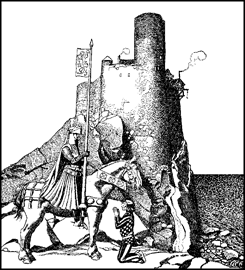 The largest Loskalmi chapters, however, have their own abbeys, free-standing churches used as places of worship for many knights from the surrounding area. Such chapters have several liturgists and other staff, and the leading wizard class liturgist, or abbot, has a function similar to that of the masters in other lands. The purpose of the abbeys is to act as a focus for venerational worship, to train liturgists, and to conduct the initiation of new adepts.
The largest Loskalmi chapters, however, have their own abbeys, free-standing churches used as places of worship for many knights from the surrounding area. Such chapters have several liturgists and other staff, and the leading wizard class liturgist, or abbot, has a function similar to that of the masters in other lands. The purpose of the abbeys is to act as a focus for venerational worship, to train liturgists, and to conduct the initiation of new adepts.
There is no overall leader or governing body for the Order of Saint Josselyne. This fact helps to maintain their neutrality, since there is no concern that the Order in, for example, Seshnela, is taking instructions from a more powerful official in a foreign country. In many parts of the West, each chapter is essentially independent, although like-minded masters operating in the same general vicinity may work together for the common good, or even meet in local conclaves to decide matters of general policy.
In other places, there is more structured hierarchy. In Seshnela, a Grand Master heads the Order, claiming authority over all Rokari chapters, including those beyond the Kingdomís borders. In Loskalm, the headquarters of the Order stands in Pethercombe in Tawars Province, and the Grand Abbot is a member of the noble class.
The Other Side
As with most other important saints, Josselyne is associated with a complex web of spell nodes on the Adept Plane. These are all connected to the Fortress of Strength on the Saint Plane, which serves as the Orderís most important node. The Fortress is a huge castle with towering walls of stone several feet thick. Those arriving in the Fortress find themselves somewhere in its array of defensive rooms and corridors. The Fortress is wholly given over to the arts of war, as if inhabited by knights alone, with no accommodation for servants or nobles. Like most nodes, it has no permanent residents of its own, although a visitor may frequently encounter other Josselyni, perhaps from foreign lands. Weapons and suits of armour decorate the walls, but cannot be removed from the Fortress.Nothing is visible through the arrow slits but grey sky, and there is no access to the battlements. This is because the node, like all others on the Saint Plane, is a self-contained entity, and travel beyond it, into whatever empty spaces may exist between the nodes, is not possible. The heart of the Fortress is its chapel, through which a supplicant may commune with the Saint himself.
The main gate of the castle opens out onto the Gods War, used by Josselyni heroquesters. Within the castle are numerous other doors that lead to the various spell nodes of the Order. The castleís floor plan is fixed, representing the solidity and permanence of its founderís ideals, so that finding such doors is relatively easy with an experienced guide. A few heroquesters claim to have discovered doors that lead to the nodes of other saints, but these seem to be less permanent, and may not have a fixed location within the Fortress.





